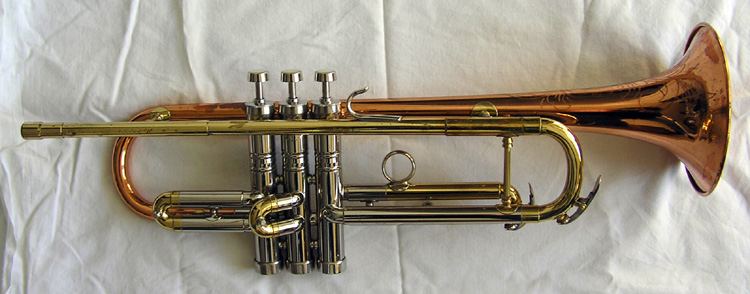Conn 10A Victor (Early Model)

Date: 1956, Owned by Christine Derksen.
Notice the coprion bell and the nickel trim. The "Early" models built between 1955 and 1957 have a fixed 3rd slide finger ring, bottom spring valves and don't have a coprion leadpipe. This is the original "Victor" design which in 1961 was re-used without the Coprion or nickel trim in the 25B, 35B and 2A (C, D and Eb Victors, respectively. See "Comparative quality of Conn instruments, part 2" for more information).
Mouthpiece wise, the 6A and 10A Victor models and the 28A Connstellation were built right in the years when Conn appears to have transitioned from short shank to long shank. I know that prior to 1955 Conn cornets were short shank only. From 1958 on they were long shank only. The intervening years, 1955-1957, are a bit uncertain. The 6A and 10A will accept both long and short shank cornet mouthpieces. I have played my 1956 10A with both types of mouthpieces and find that the short shank mouthpiece has less resistance and seems to respond better. However, I am told that the 1956 and 1957 6A and 10A Victor models originally came with long shank mouthpieces. So take your pick. If you own a 1955-1957 28A Connstellation, 10A Victor or 6A Victor, you might want to try it with a short shank cornet mouthpiece if you have one available, to compare and make up your own mind. For more information, drop me an e-mail.
How to tell a 10A Victor long cornet and a 10B Victor trumpet apart? The differences are quite subtle, but you should be able to tell if you know what you are looking for. All models for which there is both a long cornet and a trumpet (6A/6B, 10A/10B, 28A/38B) have a letter "A" or "B" stamped on the mouthpiece receiver. An "A" indicates a cornet leadpipe, a "B" indicates a trumpet leadpipe. The second way is to look at where the leadpipe widens out to accomodate the main tuning slide. On a trumpet this happens directly after the leadpipe finger hook, on a long cornet about an inch further down the leadpipe from the fingerhook. See picture. For a discussion on the merits of long model cornets such as this one, see The Long Model Cornet: Fish Nor Fowl?.
As far as I can tell at this point, all Conn cornets built before 1958 take a short shank cornet mouthpiece as opposed to the 2¾" "Bach-style" long shank cornet mouthpiece. The long shank cornet mouthpieces won't properly fit a pre-1958 Conn cornet and won't give the proper intonation or playing characteristics of a short shank cornet mouthpiece. All of Conn's "Connstellation" cornet mouthpieces are long shank mouthpieces. The "Improved Precision" Conn mouthpieces such as the Conn 4 are long shank if there is a "ridge" halfway down the shank, and short shank if there is no ridge (in which case it is a "Precision" mouthpiece). All Conn cornet mouthpieces built before the "Improved Precision" series (ridge), such as the "Precision" series (no ridge) are short shank mouthpieces.
See also the "Late" version, called the 10A Artist.
What Conn said in 1956:
A brand new cornet, with the lines of a trumpet and acoustical qualities comparable to the 28A. Beautiful
cornet tone, accurate scale throughout. Features amazing seamless Coprion bell; Clickless Crysteel
valves with famous bottom spring design; acoustically correct mouthpipe; modern valve tips
and top and bottom caps. Nickel silver finger hook, third valve ring and water keys. Length 21 3/8", weight
2 lbs. 10 oz., bell diameter 5 1/8". Outfit includes sturdy, handsome Connstellation case, mouthpiece and
music lyre.
Highly polished brass, beautiful nickel trim, with Coprion bell, clear lacquer overall.